By MICHAEL CONWAY
The 13-mile stretch of road from Revere to Danvers that encompasses Route 1 north of Boston has earned fame for its establishments fronted by garish signs and iconic, kitschy landmarks such as orange dinosaurs and fiberglass cows. Eye-catching to some, eyesores to others, still standing or not, they’ve proved memorable to both tourists and locals alike. Strip malls and megastores by corporate giants now coexist with small businesses and Square One Mall. Beloved restaurants have disappeared and motels touting color TV and telephones in every room have pretty much vanished. The brazen to blasé landmarks proved newsworthy and cultural, and cherished by locals.
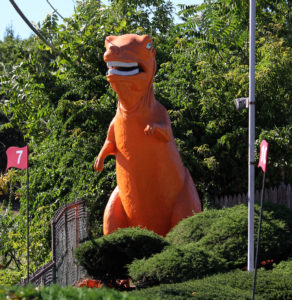
The Big Orange Dinosaur emerges from the greenery at the former Route 1 mini-golf complex. | Photo: Owen O’Rourke
In August, Lynnfield residents became saddened and more than perturbed as they witnessed a New Hampshire company bulldoze The Ship restaurant, mast and all, into a sea of cement and dust. The Hilltop Steakhouse cows were previously sent out to pasture, and the Big Orange Dinosaur at the mini-golf/batting cage/Dairy Castle complex was saved from extinction thanks in part to a successful Facebook page petition. Hatched in South Boston and moved to Saugus on a flatbed truck, the androgynous T. rex today stands perched high on a nearby wall as if angered by Route 1’s mind-boggling traffic.
U.S. Route 1 spans approximately 2,400 miles along the East Coast from Florida to the Canadian border in northern Maine. In Massachusetts, it consists of two former turnpike roads of which the Newburyport Turnpike is the oldest. 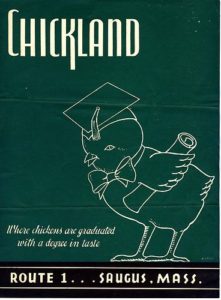
Built from Boston to Newburyport by more than 300 laborers, teams of oxen and horses, it opened in 1805 as a straight toll road bypassing Salem, in hopes of promoting Newburyport commerce. Proponents claimed it would cut the travel time by a third compared to the old Bay Road (Route 1A).
However, long before its metamorphoses into the double three-lane highway of today, great entertainment was within earshot of Route 1. During the second half of the 1800s, not far from the Rowe rock quarry, Franklin Park, aka Old Saugus Race Course, was a sought out sports venue at the far edges of marshlands on the Saugus/Revere line. Couples first strolled past willow trees to gain entrance through its double-sphere landmark and watch harness racing. Spectators sat in grandstands fronting a sordid hotel known for alleged illicit behaviors including prostitution. In 1898, the New England Society for the Suppression of Vice alleged illegal gambling took place. The track later closed when locals complained of the questionable patrons drawn to the track. The land became Atwood Park, a popular airfield that hosted fairs, picnics, motorcycle races, bonfires and circuses. The track’s legacy remains etched into the planet and is available via satellite at Google Earth.
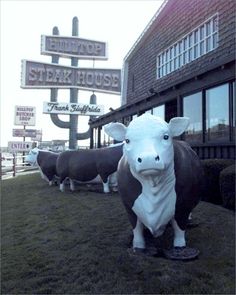 During the 1930s, Route 1 became a paved road built in sections by widening existing roads and bypassing congested areas. The Tobin Bridge opened in 1950, offering motorists easier access to the aforementioned 13-mile stretch of kitschy highway. Whether to dine or shop, swim or skate, crowds swarmed toward Route 1 compassed by such iconic landmarks as Mr. Peanut in Peabody and the Red Coach Grill in Saugus. One could eat meatballs at Augustine’s, buy a Singer sewing machine at the New England Shopping Center (Square One Mall’s precursor) or watch adult entertainment at DB’s Golden Banana if one just followed the signs.
During the 1930s, Route 1 became a paved road built in sections by widening existing roads and bypassing congested areas. The Tobin Bridge opened in 1950, offering motorists easier access to the aforementioned 13-mile stretch of kitschy highway. Whether to dine or shop, swim or skate, crowds swarmed toward Route 1 compassed by such iconic landmarks as Mr. Peanut in Peabody and the Red Coach Grill in Saugus. One could eat meatballs at Augustine’s, buy a Singer sewing machine at the New England Shopping Center (Square One Mall’s precursor) or watch adult entertainment at DB’s Golden Banana if one just followed the signs.
Kids in pajamas sat atop paneled station wagons under Revere Drive-In’s looming screen. Jazz lovers grooved at Lennie’s on the Turnpike in Peabody. Foodies were in nirvana; in addition to The Ship, Hilltop and Augustine’s, long gone options abounded including Jolly Jorge’s, Adventure Car Hop, Chickland, Russo’s Candy House, Town Lyne House, Yoken’s and numerous others. The Continental, Prince and its Leaning Tower of Pizza and others continue to thrive.
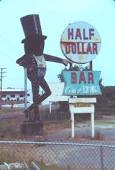
The Half Dollar spawned from Mr. Peanut in Peabody.
From the kitschy land of spawning car dealerships and cyclical gas stations, iconic landmarks remain memorably ingrained. Dads got impatient waiting in the Hilltop’s wraparound waiting line, and drove the family over to Valle’s to wait just as long. Moms veered from the highway onto Route 99 to watch Engelbert Humperdinck at the former Chateau de Ville, which evolved into the The Palace nightclub. Kids teased their younger siblings by warning of escaped lunatics hitchhiking down the hill from the old Danvers State Hospital “for the criminally insane.”
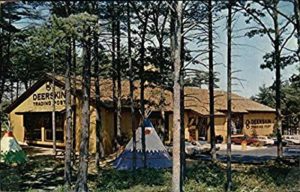 The land once home to Wampanoag Indians, Route 1’s historical transformation is recorded in books and maps, photos and slides, by grandparents and Google. Today, gleaming dollar menus at multitudinous fast food drive thrus have replaced iconic landmarks, like the Deerskin Trading Post teepees. Yet, today the Kowloon tiki god welcomes Route 1 motorists headed north, and the Hilltop cacti probe the southbound skies, you’re summoned once again, “to Sioux City.”
The land once home to Wampanoag Indians, Route 1’s historical transformation is recorded in books and maps, photos and slides, by grandparents and Google. Today, gleaming dollar menus at multitudinous fast food drive thrus have replaced iconic landmarks, like the Deerskin Trading Post teepees. Yet, today the Kowloon tiki god welcomes Route 1 motorists headed north, and the Hilltop cacti probe the southbound skies, you’re summoned once again, “to Sioux City.”
Michael Conway is a freelance writer. He can be reached at mjcon6@msn.com.






